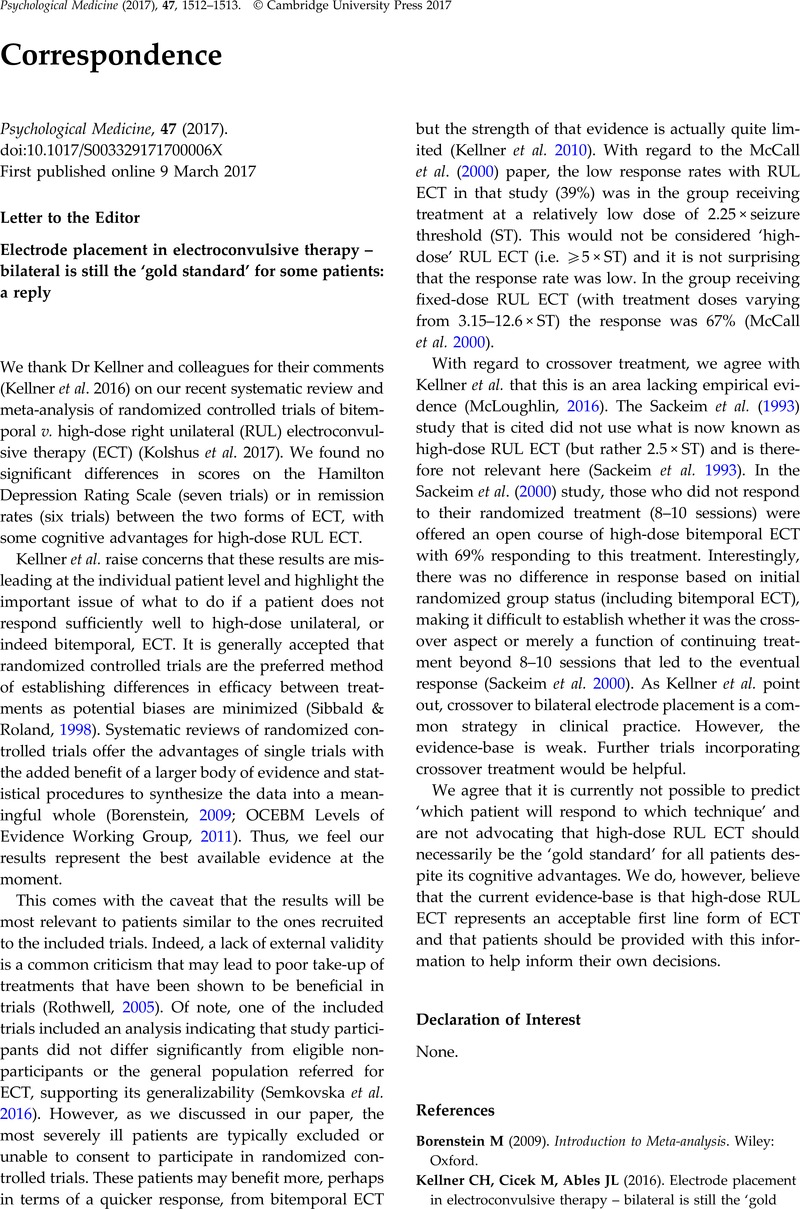No CrossRef data available.
Article contents
Letter to the Editor: Electrode placement in electroconvulsive therapy – bilateral is still the ‘gold standard’ for some patients: a reply
Published online by Cambridge University Press: 09 March 2017
Abstract
An abstract is not available for this content so a preview has been provided. Please use the Get access link above for information on how to access this content.

- Type
- Correspondence
- Information
- Copyright
- Copyright © Cambridge University Press 2017
References
Kellner, CH, Cicek, M, Ables, JL (2016). Electrode placement in electroconvulsive therapy – bilateral is still the ‘gold standard’ for some patients [Letter]. Psychological Medicine. doi:10.1017/S0033291716003536.Google Scholar
Kellner, CH, Knapp, R, Husain, MM, Rasmussen, K, Sampson, S, Cullum, M, McClintock, SM, Tobias, KG, Martino, C, Mueller, M, Bailine, SH, Fink, M, Petrides, G (2010). Bifrontal, bitemporal and right unilateral electrode placement in ECT: randomised trial. British Journal of Psychiatry
196, 226–234.Google Scholar
Kolshus, E, Jelovac, A, McLaughlin, DM (2017). Bitemporal v. high-dose right unilateral electroconvulsive therapy for depression: a systematic review and meta-analysis of randomized controlled trials. Psychological Medicine
47, 518–530.Google Scholar
McCall, WV, Reboussin, DM, Weiner, RD, Sackeim, HA (2000). Titrated moderately suprathreshold vs fixed high-dose right unilateral electroconvulsive therapy: acute antidepressant and cognitive effects. Archives of General Psychiatry
57, 438–444.Google Scholar
McLoughlin, DM (2016). Response to Kellner and Farber: addressing crossover of high-dose right unilateral ECT to bitemporal ECT. American Journal of Psychiatry
173, 731–732.CrossRefGoogle ScholarPubMed
OCEBM Levels of Evidence Working Group (2011). The Oxford Levels of Evidence 2. Oxford Centre for Evidence-Based Medicine (http://www.cebm.net/index.aspx?o=5653).Google Scholar
Rothwell, PM (2005). External validity of randomised controlled trials: ‘to whom do the results of this trial apply?’
Lancet
365, 82–93.Google Scholar
Sackeim, HA, Prudic, J, Devanand, DP, Kiersky, JE, Fitzsimons, L, Moody, BJ, McElhiney, MC, Coleman, EA, Settembrino, JM (1993). Effects of stimulus intensity and electrode placement on the efficacy and cognitive effects of electroconvulsive therapy. New England Journal of Medicine
328, 839–846.Google Scholar
Sackeim, HA, Prudic, J, Devanand, DP, Nobler, MS, Lisanby, SH, Peyser, S, Fitzsimons, L, Moody, BJ, Clark, J (2000). A prospective, randomized, double-blind comparison of bilateral and right unilateral electroconvulsive therapy at different stimulus intensities. Archives of General Psychiatry
57, 425–434.Google Scholar
Semkovska, M, Landau, S, Dunne, R, Kolshus, E, Kavanagh, A, Jelovac, A, Noone, M, Carton, M, Lambe, S, McHugh, C, McLoughlin, DM (2016). Bitemporal versus high-dose unilateral twice-weekly electroconvulsive therapy for depression (EFFECT-Dep): a pragmatic, randomized, non-inferiority trial. American Journal of Psychiatry
173, 408–417.Google Scholar
Sibbald, B, Roland, M (1998). Understanding controlled trials. Why are randomised controlled trials important?
British Medical Journal
316, 201.Google Scholar




